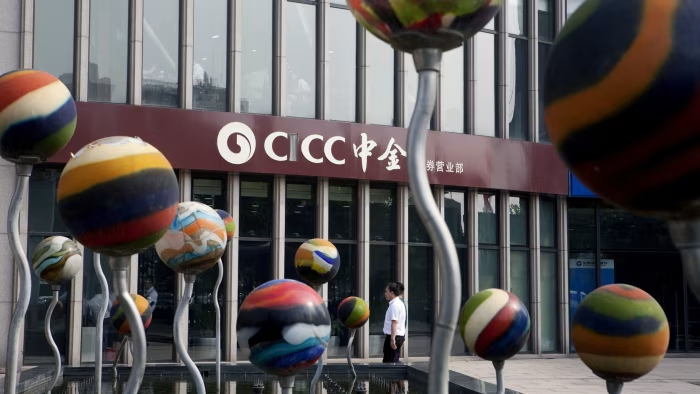This is an audio transcript of the FT News Briefing podcast episode: ‘The bidding war for Warner Bros Discovery begins’
Marc Filippino
Good morning from the Financial Times. Today is Thursday, November 20th, and this is your FT News Briefing. Nvidia released another splashy earnings report and the bidding war for Warner Bros Discovery officially kicks off today. Plus, critics say that China’s growth numbers don’t quite add up. We’ll explain why. I’m Marc Filippino and here’s the news you need to start your day.
[MUSIC PLAYING]
News about the AI sector has been pretty gloomy lately, but Big Tech investors saw a ray of sunshine yesterday. Nvidia reported that sales of its chips grew even faster than Wall Street expected last quarter and its revenue forecast for the current quarter was well above estimates. Nvidia’s shares were higher in after-hours trading. They were down 11 per cent from their peak in early November before the earnings report came out.
Nvidia’s results are a bellwether for the health of the AI sector. That’s because it’s advanced chips power important models like ChatGPT. The earnings report could help soothe investor worries about massive valuations of big US tech groups and all the money those companies are spending on chips and data centres.
[MUSIC PLAYING]
For the fourth time since September, Paramount’s chief executive David Ellison is making a bid to buy Warner Bros Discovery. But this time he has some competition and this bidding war has been described as Paramount’s to lose. Here to tell us more is the FT’s James Fontanella-Khan, our US finance editor. Hey James.
James Fontanella-Khan
Hi, Marc.
Marc Filippino
James, can you tell us a little bit about David Ellison’s back-story when it comes to bidding for Warner Bros Discovery?
James Fontanella-Khan
I think we need to take a step back and remind our listeners that David Ellison acquired Paramount not long ago. With the ink barely dry on that deal, he immediately started preparing a bid for Warner to create one of the most powerful Hollywood entertainment and sport media companies, and that’s where we are at the moment. He thought he didn’t have any competition to start with. Essentially, he put it in play and others came knocking because it’s a once-in-a-generation opportunity to buy a famed movie studio and more.
Marc Filippino
Yeah, and more includes HBO, which is nothing to sniff at. This competition you’re talking about James, who else is out there at the moment?
James Fontanella-Khan
In addition to Paramount, you have Comcast, which is a kinda more traditional rival of Warner, and then more surprisingly, you have Netflix.
Now, nobody really expected Netflix to be there. The streaming giant has never really done any mega M&A and nobody thought they’d be interested in owning some of the other assets that are currently in the Warner stable, particularly its cable and its news business. And in fact, there is a vibrant debate inside of Netflix over whether they should even be in the mix.
A lot of people think they’re just participating in the deal because, again, it’s a rare opportunity to look a little closer into the business of a rival.
Marc Filippino
James, do bids have to get in today?
James Fontanella-Khan
Bids will start trickling in and then what we should expect is a little back and forth with Warner examining the offers and then it’ll go back to the various parties involved and see who wants to counterbid. And that’s how the bidding process will go on for at least a couple of weeks.
Marc Filippino
I mentioned earlier that this is Ellison’s and Paramount’s bid to lose. Why is that the case?
James Fontanella-Khan
First and foremost, he was the first one to come out in the open to express interest in this asset. He has the capital. His dad is Larry Ellison. They own Oracle, the family. They are flush with cash. In addition to that, they’ve been talking to additional backers, including in the Middle East. So from a regulatory perspective, probably faces the least amount of opposition. And finally, these days, every deal has to go through Washington, DC. We can say that Larry Ellison is a good friend of US President Donald Trump, and he would probably be happy to note the Ellison’s control CBS and CNN, who have a, let’s say, history with the current US president.
Marc Filippino
Now, James, you had described this potential deal between Warner Bros Discovery in Paramount as historic. What impact could this ultimately have on the business of Hollywood?
James Fontanella-Khan
This is gonna be cataclysmic for Hollywood. For starters, you’re seeing what’s going on at Paramount. There’s already been quite a few job cuts as part of a broader restructuring that Ellison is imposing at Paramount. And you can only expect if you bring two big companies together, there’ll be more job cuts.
On the flip side though, from an investor perspective, if Ellison does emerge on top, you’ll have a much larger, more robust player in that space that can precisely compete with Netflix, who can compete with Amazon, who can compete with Google. Because let’s remember Google owns YouTube, which is a huge player when it comes to media and entertainment.
Marc Filippino
A lot at stake here. James Fontanella-Khan is the FT’s US finance editor. Thanks, James.
James Fontanella-Khan
Thank you.
[MUSIC PLAYING]
Marc Filippino
UK inflation fell to 3.6 per cent in October. That’s down from 3.8 per cent a month earlier. And this has raised expectations that the Bank of England will cut interest rates next month. Traders are betting on a quarter-point rate cut in December. The data comes just a week ahead of the UK’s autumn budget. Chancellor Rachel Reeves is expected to raise taxes as the country’s economy continues to struggle. It grew just a 10th of a per cent last quarter.
[MUSIC PLAYING]
For decades, China’s growth rates were the envy of the world. Although its official statistics were considered somewhat unreliable. Now, a loss of momentum caused by trade tensions with the US and a property slowdown have made questions about the data more urgent. People are trying to work out what’s going on in one of the world’s most important economies.
I’m joined now by Thomas Hale, the FT Shanghai correspondent, to discuss this. Hi Tom.
Thomas Hale
Hi. Thanks for having me.
Marc Filippino
So what are the main problems with China’s official economic data?
Thomas Hale
I think the biggest problem right now is that the type of GDP data that other major economies publish every quarter, which involves a breakdown loosely of investment consumption and net exports, we are not getting that quarterly data in China. And it makes analysing the economy within a given year more difficult than it would be elsewhere.
But really just stepping back over the decades of China’s economic transition, China retains a target-driven economic system. It sets targets for GDP growth. So we’ve seen concerns over local officials reporting inflated data, and there is evidence that the National Bureau of Statistics has made adjustments, downwards adjustments to the data it receives from local governments because of that issue.
Marc Filippino
Now, can you give us an example of where the data fall short?
Thomas Hale
Yes. So in other major economies, we would be getting quarterly GDP data on investment. In China, we’re not getting this, and instead, China produces its own monthly investment data called fixed asset investment. And analysts rely very heavily on this data to interpret what’s going on with investment in China.
Now currently, that data is showing a very steep decline. But we are not seeing a comparable impact on overall GDP in China. So this poses a real puzzle to analysts as to how we can interpret this fall in China’s unique fixed asset investment data and how its GDP growth will ultimately reflect that investment decline.
Marc Filippino
Let’s go back a little bit, Tom. How has China’s approach to data evolved in recent decades since it started opening up its economy in the 1990s.
Thomas Hale
China adopted GDP as a kind of international standard in as late as 1993. And obviously, there was a monumental, practical challenge. And there was a lot of collaboration with the west on that front. And what we’ve really seen is a decline in that engagement.
And so right now we have a lot less visibility than we would’ve 10, 15 years ago. The other major challenge is that certain data that was available in the past has been discontinued by the National Bureau of Statistics. For example, before 2018 we had breakdowns of fixed asset investment by different sectors in terms of the amount of investment and from 2018 onwards, we no longer have that.
Marc Filippino
Now, Tom, you got at this a little bit earlier, but how else does China’s data differ from other major economies?
Thomas Hale
Although China has transitioned from a planned economy decades ago, there are certain elements that appear to linger. One of them is that China’s data focuses very much on hard production data, the kind of countable data that would’ve played a big role prior to its opening up as well.
So I think the data China is producing is differing somewhat from the kind of data you would get in the US and the UK where the economies are much more focused on services. Targets might make more sense on hard production data or on investment, which might be seen as more easily measurable than something like consumption of services.
So I think there are definitely relationships between the way an economy is structured and the way economy is run and the type of data which arises from that economy.
Marc Filippino
And so given everything that we’ve discussed, is there any chance that China might ever be more transparent with its economic data?
Thomas Hale
If we zoom out and think about the development of China’s economy is in many ways unrecognisable to the economy that it had in the 1980s. We do see a much more services-based economy. If China continues to develop in that direction, there might be a case to be made that the way it approaches its data, the way it approaches its statistics will ultimately change.
Marc Filippino
Tom Hale is the FT. Shanghai correspondent. Thanks, Tom.
Thomas Hale
Thank you.
Marc Filippino
Before we go, we told you earlier this week that even though the US government has reopened, it still has a hole in its economic data. The FT’s Myles McCormick told us that while federal employees were furloughed, they couldn’t collect all the usual data to compile inflation and jobs reports for the month of October, which are key metrics the Federal Reserve will use when it meets next to decide on interest rates.
Myles McCormick
We’ll still be flying blind to some extent. It’s unlikely to have October information for inflation on the labour market and it may or may not have information for the month of November.
Marc Filippino
And Myles was right. The Bureau of Labor Statistics said yesterday, it won’t publish the October jobs report in full, but it is set to release all of September’s data today. We’ll see how the Fed handles all this when it meets next month. The central bank reported minutes from the last meeting yesterday. It showed members were split over a rate cut in December.
[MUSIC PLAYING]
You can read more on all these stories for free when you click the links in our show notes. This has been your daily FT News Briefing. Check back tomorrow for the latest business news.







